Monday 27th April 2015
I took breakfast at my hotel in the open air restaurant, looking out across the river and then checked-out.
 View across the Ayeyarwaddy River from the Bagan Thiripyitsaya Sanctuary Resort.
View across the Ayeyarwaddy River from the Bagan Thiripyitsaya Sanctuary Resort.
As arranged, I was collected from my hotel at 07:50 and taken to the monastery. The Clinic was strangely quiet on a non-opening day but, as usual, I was offered another breakfast at the monastery. I accepted congee (a rather watery 'rice pudding' flavoured with salt) and then one of Dr. Hla Tun's assistants had brought in a home-made vegetable soup for me to try. It was good.
Unusually, the Head Monk was not present but, as we were finishing breakfast, he appeared and summoned Dr. Hla Tun and I to the monastic school building I'd not been in before. A prize-giving ceremony was already in full-swing and the head monk resumed his elaborately-carved chair at one end of the assembly room, flanked on either side by two monks, each seated on carved chairs. The room was crowded with schoolchildren and their parents.
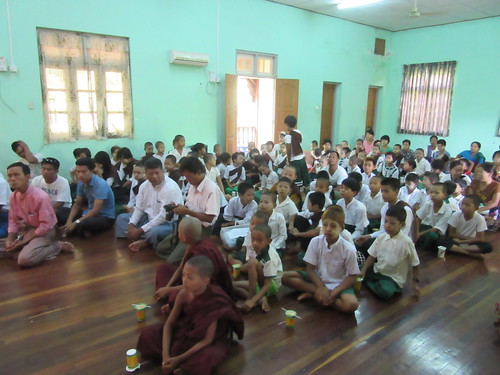 Prize-giving at the monastic school.
Prize-giving at the monastic school.
Having completed their examinations, this was the annual prize-giving. I've mentioned before the Myanmar has not succumbed to the "all must have prizes" syndrome which afflicts the United Kingdom. Children are respectful, disciplined and expect to work hard if they are to succeed. Each prizewinner was being presented with a framed, coloured certificate and a gift, the audience would applaud and what appeared to be an 'official photographer' would record the scene. Dr. Hla Tun made one presentation then I was instructed to make the next presentation. The Doctor and I were only there for a few minutes so I couldn't observe too much but I felt privileged to have seen the scene.
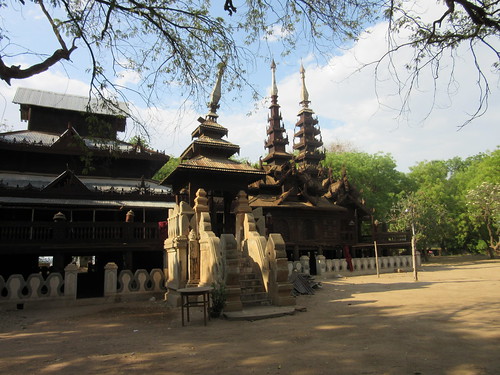 The oldest monastery building is mainly wooden and heavily decorated.
The oldest monastery building is mainly wooden and heavily decorated.
The monastery 'people carrier' was being packed with stationery which we were to distribute that morning. This Toyota vehicle was equipped with a wheelchair lift at the rear and a sign in the front window indicating that we were engaged on monastery-sponsored work. I noticed that, at the the main road toll station leaving Bagan, the road toll was waived. Monks are held in high regard in Myanmar.
We left the monastery and made the short drive to the 'Hotel @ Tharabar Gate' (yes, they use the ampersand, presumably to indicate how with-it they are). Here, we collected the newly-qualified doctor from Myanmar and her parents, together with her Chinese-American doctor friend. Our route then took us past the Ananda Temple onto the dual carriageway which, somewhat improbably, heads across the Bagan Plain, with pagodas all around.
At Nyaung Oo we took the dual carriageway out of town and I noticed 'kerb painters' at work. On dual carriageways, the right-hand kerb (remember, they now drive on the right) is painted white but the left-hand kerb is painted alternately red then white. Groups of male and female workers were quatting in the gutter (ignoring passing traffic) each with a pot of paint and a brush re-painting the kerbs. One group had white paint and, in a couple of hundred yards, the next group would have red paint and so on. When we returned in the afternoon, the work was still being done.
 'Kerb painters' at work on the dual-carriageway leaving Nyaung Oo.
'Kerb painters' at work on the dual-carriageway leaving Nyaung Oo.
The changes taking place in Myanmar are very visible in this area - various construction projects are in hand: hotels and apartments (I think). Once we'd passed the airport and railway station turns, the road became single carriageway but still with a decent 'tarmac' surface' apart from the section across the currently-dry river bed. We passed a number of filling stations which are either new or still being completed. Eventually we passed into the sandy plain filled with Toddy Palms and, dotted around, the simple bamboo houses equipped with a still for producing the rum-like 'Toddy'.
 The short, brick chimney on the simple bamboo house indicates a still.
The short, brick chimney on the simple bamboo house indicates a still.
I wrote a brief description of 'toddy' in a 2009 post here (with a link to a few photographs).
We turned off the tarmac road onto the sandy track which, after around two miles of careful driving, took us to Chauk Kan.
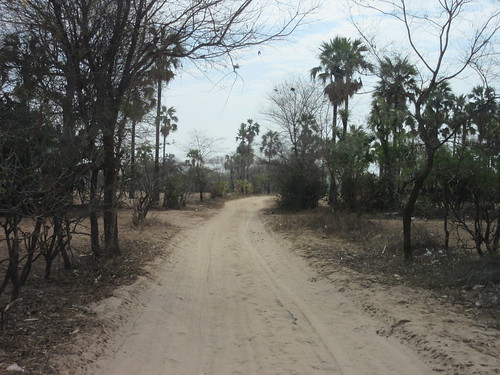 The sandy track to Chauk Kan village.
The sandy track to Chauk Kan village.
Chauk Kan
This was my fourth visit to the school here (my last visit is described in Visiting Bagan Schools and that post has links to the earlier visits).
Although the school was currently closed for the summer holiday, the assembly hall was full of excited pupils, anxious to receive their distribution of free stationery.
 Excited but well-behaved pupils in the assembly hall.
Excited but well-behaved pupils in the assembly hall.
The headmaster first offered us refreshments, then we joined the pupils in the assembly hall and ten girl dancers entertained us, accompanied by 'pop' music from a sound system. In the meantime, the stationery had been set up out of doors for distribution.
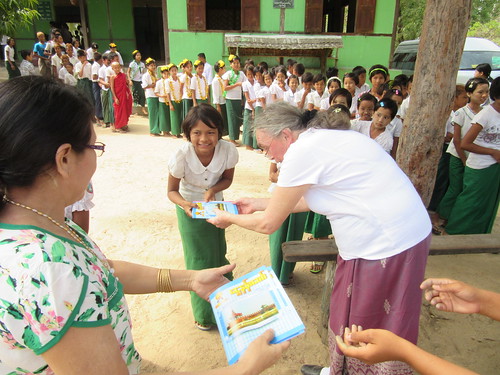 Pupils queuing to receive stationery.
Pupils queuing to receive stationery.
The doctor had also brought a selection of spectacles allowing local elderly people to each select a suitable pair.
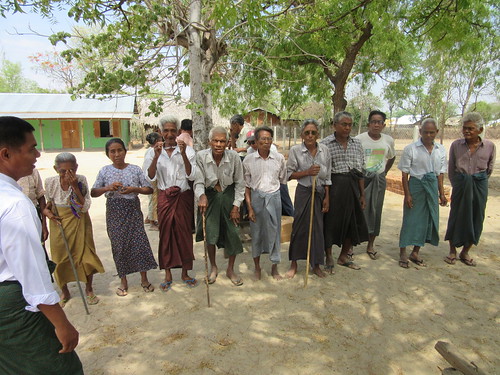 Villagers pose with their new spectacles.
Villagers pose with their new spectacles.
After the visitors had been shown around the school buildings, we returned to our car and retraced our route back to the main road, where we continued to Htee Pu. The village is reached by another long, sandy track which diverges from the tarmac road to Mount Popa at a junction marked by a concrete signpost.
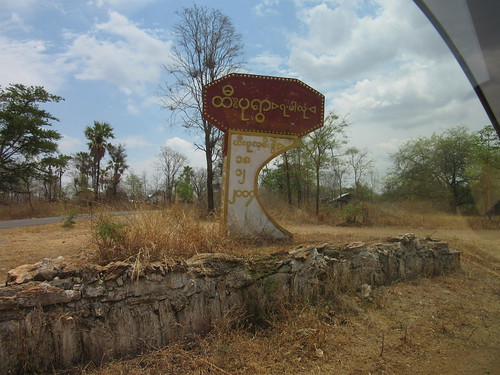 Concrete signpost at the junction with the road to Mount Popa.
Concrete signpost at the junction with the road to Mount Popa.
Htee Pu
Htee Pu was the first school I visited in the Bagan area, back in 2009. Since then, I've returned in 2010 (when a new, donated school building was opened), 2011 and 2012. In 2013, I visited schools at Nga-Minn-May and Chauk-Kan but time did not permit a visit to Htee Pu. But I visited in 2014 and, as described below, 2015.
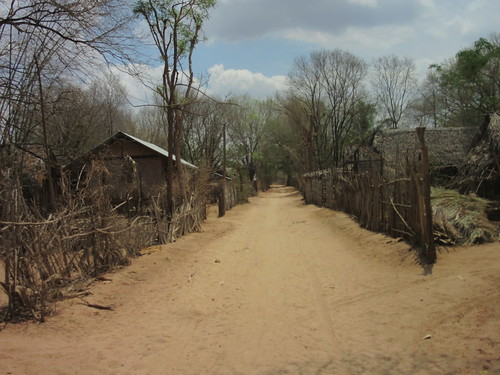 Part of Htee Pu village.
Part of Htee Pu village.
We drove into the monastery compound and parked near the main monastery building. The head monk greeted us and explained that the headmaster was away on a training course since the school was closed for the summer holiday. The visitors were each presented with flowers in welcome.
 The Myanmar doctor, her parents and the Chinese-American doctor, presented with flowers.
The Myanmar doctor, her parents and the Chinese-American doctor, presented with flowers.
A large, colourful, bamboo-framed temporary shelter had been erected in the monastery compound and, school holidays or not, it was packed with waiting children, a group of lady teachers and villagers. The children were seated on the ground but a number of moulded plastic chairs had been provided for the visitors and some of the elderly villagers. A wooden stage covered with matting had been erected across one end, flanked on either side by serious-looking loudspeakers mounted on oildrums. Our visit was clearly being marked by a concert. Once the visitors were seated, we were treated to a variety of dances by different groups of children.
 The audience was torn between watching the dance and their exotic visitors.
The audience was torn between watching the dance and their exotic visitors.
 A boy-and-girl dance, with lots of actions.
A boy-and-girl dance, with lots of actions.
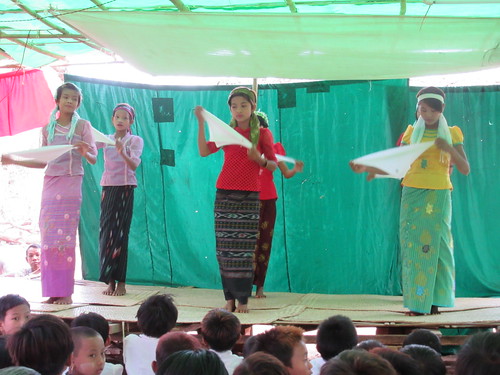 A dance with handkerchiefs.
A dance with handkerchiefs.
 Younger children performing.
Younger children performing.
During the more energetic dances, we worried about the strength of the stage but all was well. Everybody then turned to face the visitors and there were brief speeches from the Head Monk and Dr. Hla Tun during which the visitors were introduced to the audience.
A short video of part of the performance is available here. After seeing the video, the 'Back Button' will return you to this post.
A series of tables was then set up in the compound and the stationery we'd brought was set out. Helped by the lady teachers, each of the visitors distributed the stationery to the children.
 Jan distributing stationery to a group of young monks.
Jan distributing stationery to a group of young monks.
As at Chauk Kan, spectacles were available and there was a flurry of activity as the appropriate prescriptions were selected.
 Spectacle selection.
Spectacle selection.
The visitors were then taken on a conducted tour of the facilities, after which there was a group photograph of visitors and lady teachers outside the building opened in 2010.
 Visitors and teachers outside the building opened in 2010.
Visitors and teachers outside the building opened in 2010.
The elderly villagers then posed for the cameras with their new spectacles.
 Elderly villagers from Htee Pu.
Elderly villagers from Htee Pu.
We were then invited to the monastery for for a snack before we left.
 A snack in the monastery.
A snack in the monastery.
Mount Popa
The Doctor decided that there was time to show his visitors the area around Mount Popa. Mount Popa, an extinct volcano, is a special place for the Burmese. Adjacent is the rock pinnacle of Taung Kalat, topped by a number of temples. My first visit was in 2009, described here. I was so impressed, I returned in 2011 and stayed at the Mount Popa Resort. That visit is described here and here.
Arriving at the town, we stopped at what appears to be a privately-developed 'Taung Kalat Viewpoint'. This attraction is still under construction and it was interesting to see the numerous concrete religious statues in various stages of completion. Having taken pictures of the rock pinnacle of Taung Kalat, nobody seemed keen to climb it. Instead, we went to a well-appointed restaurant and took a very pleasant lunch.
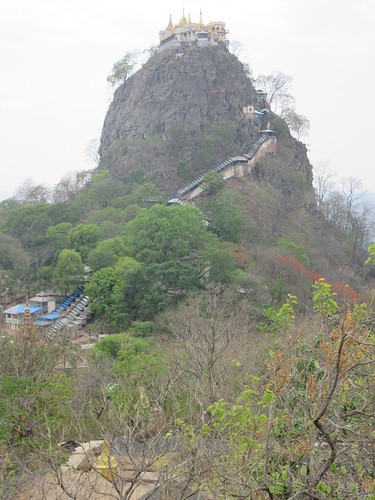
Taung Kalat, from the Viewpoint.
We drove back to Bagan, returning four people to the 'Hotel @ Tharabar Gate' before driving to the Bagan Monastery, collecting our luggage and saying our goodbyes. We were then driven to Bagan Airport to check in for the Air Bagan flight to Yangon. The flight, operated by Air Bagan's hardworking ATR72 (registration XY-AIH) was on time. Back at Yangon, we drove to the Doctor's house where I was to spend a final night.
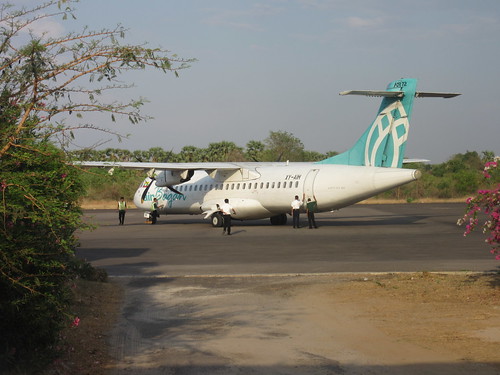 Air Bagan's ATR72 XY-AIH on arrival at Bagan.
Air Bagan's ATR72 XY-AIH on arrival at Bagan.
The following morning, the next 'segment' of my trip was to start with a flight to Putao, in the far north of Myanmar.
Go to next post on this trip.
All my posts describing this trip to Myanmar can be found here.
Previous Posts describing my visits to Htee Pu
2009.
2010.
2011.
2012.
2014.
My pictures
The following albums (on Flickr) hold pictures relevant to this post:-
Bagan Monastery and Prize-giving Ceremony.
Around Bagan, 2015.
Visit to Chauk Kan, 2015.
Visit to Htee Pu, 2015.
Around Mount Popa, 2015.
All my albums for this trip can be found here.
[Text and pictures added 17th, 22nd and 23rd June 2015, videos added 14th July 2015]
